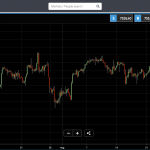
Trading Oil to the Downside
WTI crude oil is currently trading at $48.43 per barrel on the Nymex and Brent crude oil is currently trading at $51.61 per barrel on the ICE. The price of crude oil has plunged approximately 10% over the past 8 days, ruffling the feathers of many in the oil industry. However, Saudi Arabia came out all guns blazing on Tuesday, 14 March and restated its commitment to stabilizing the global oil market. There are discrepancies about the quantity of oil produced and exported by Saudi Arabia, and the amount the country claims to have pumped during February. The subsequent uncertainty led to a massive selloff of crude oil as speculators shorted the commodity on the markets. In November 2016, the world’s biggest oil cartel, OPEC, agreed to cut production to reduce oil inventories. The OPEC agreement came into place in January 2017. While prices have risen somewhat since then, recent trends have been bearish. The Saudi’s admitted to some misunderstanding between the agreed-upon figures, and the actual figures.
Saudis Spin Oil Supply Numbers to Calm Speculative Sentiment
The Kingdom of Saudi Arabia reported that it was producing 9.9 million barrels per day (February 2017), lower than the 10.1 million barrels per day that it agreed to with other OPEC producers. The compliance percentage among OPEC countries was 91% in February, but only 40% with Russia. By Wednesday, 15 March 2017, crude oil prices were up 1.6% following Saudi Arabia’s clarification. There is tremendous anxiety in oil markets, particularly from OPEC countries who are hoping that the price will remain above $50 per barrel throughout 2017. At this price level, OPEC producers would be able to meet budgetary targets while keeping US shale oil producers unprofitable. The higher the price crude oil rises, the greater the enticement for WTI crude oil producers to enter the market. This ultimately results in excess supply and decreased prices.
Unfortunately for Saudi Arabia and other OPEC countries, US oil production is on the rise. According to the EIA (Energy Information Administration), the number of oil producers has consistently risen for 5 months on the trot. By February 2017, US oil producers were pumping out 9 million barrels per day – the highest level in 1 year. The increased output is facing challenges from declining demand. As growth wanes in 2017, oil producers will be unable to eliminate the supply glut that has been growing. Any hopes of a rebalancing of the oil markets were quickly dashed by the International Energy Agency (IEA) which called for patience from investors.












Leave A Comment